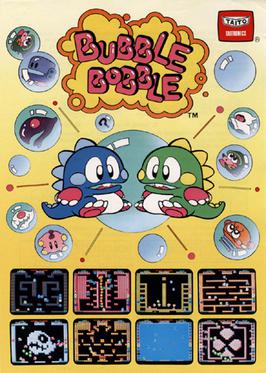
Bubble Bobble is a 1986 platform game developed and published by Taito for arcades. It was distributed in the United States by Romstar, and in Europe by Electrocoin. Players control Bub and Bob, two dragons that set out to save their girlfriends from a world known as the Cave of Monsters. In each level, Bub and Bob must defeat each enemy present by trapping them in bubbles and popping, who turn into bonus items when they hit the ground. There are 100 levels total, each becoming progressively more difficult.

Wrecking Crew is an action game developed and published by Nintendo. Designed by Yoshio Sakamoto, it was first released as an arcade video game for the Nintendo VS. System in 1984, titled Vs. Wrecking Crew with a simultaneous two-player mode. It was released as a single-player game for the Family Computer (Famicom) console in 1985, and as a launch game for the Nintendo Entertainment System (NES) later that year. A sequel, Wrecking Crew '98, was released in Japan in 1998 for the Super Famicom.
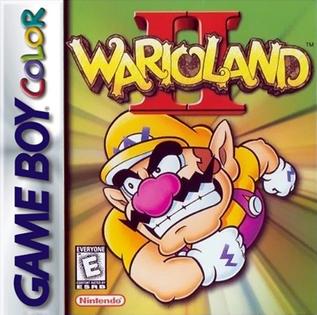
Wario Land II is a 1998 platform video game developed and published by Nintendo for the original Game Boy. It was later re-released and optimised for the Game Boy Color. In the game, Wario has to recover his treasure from Captain Syrup. The Game Boy Color version was released for the Nintendo 3DS Virtual Console in 2012.

Wario Land 4 is a 2001 platform game developed by Nintendo and released for the Game Boy Advance. Wario has to gather four treasures to unlock a pyramid and save Princess Shokora from the Golden Diva.

Balloon Fight is an action video game developed by Nintendo and HAL Laboratory and published by Nintendo. The original arcade version was released for the Nintendo VS. System internationally as Vs. Balloon Fight, while its Nintendo Entertainment System counterpart was released in Japan in 1985 and internationally in 1986.

Excitebike is a motocross racing video game developed and published by Nintendo. In Japan, it was released for the Famicom in 1984 and then ported to arcades as VS. Excitebike for the Nintendo VS. System later that year. In North America, it was initially released for arcades in 1985 and then as a launch game for the Nintendo Entertainment System later that year, becoming one of the best-selling games on the console. It is the first game in the Excite series.

Masayuki Uemura was a Japanese engineer, video game producer, and professor. He was known for his work as an employee of Nintendo from 1971 to 2004, most notably for serving as a key factor in the development of the Nintendo Entertainment System.

The Nintendo VS. System is an arcade system that was developed and produced by Nintendo. It is based on most of the same hardware as the Family Computer (Famicom), later released as the Nintendo Entertainment System (NES). As Nintendo was planning to release the NES in North America, they were aware of the video game crash of 1983 and its effects on the home console market. However by March 1984 the arcade industry recovered enough for a plan to introduce NES titles there, with the VS. System later being a presentation to players who did not yet own the console. It became the first version of the Famicom hardware to debut in North America.

Battle Clash is a 1992 light gun shooter video game developed by Intelligent Systems and published by Nintendo for the Super Nintendo Entertainment System. It is one of several titles that requires the Super Scope light gun. The plot takes place in a futuristic post-apocalyptic Earth, where battles are fought with mechs called Standing Tanks (STs) and the winner takes control of the world. A young man named Mike Anderson participates in the Battle Game to face the ruthless champion Anubis and avenge his father's death. The player acts as the gunner of the ST Falcon piloted by Anderson, taking on Anubis and his subordinate chiefs in one-on-one fights.

DK: King of Swing is a 2005 puzzle-platform game developed by Paon and published by Nintendo for the Game Boy Advance. King of Swing diverges from the gameplay of other games in the Donkey Kong series, instead featuring characters rotating around pegs to progress similar to the NES game Clu Clu Land. King of Swing has a single-player adventure mode, as well as a competitive multiplayer mode for up to four players. The game received mixed reception.
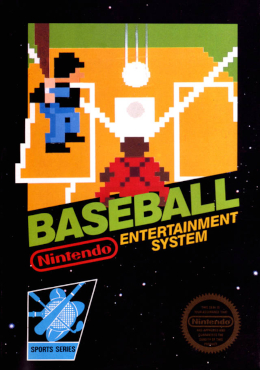
Baseball is a video game from Nintendo. It was released December 7, 1983, after the July 15 launch of the Famicom in Japan. In 1984, it was ported to the VS. System arcade as VS. Baseball with additional graphics and speech, becoming a number one hit in Japan and North America that year. It was localized as a Nintendo Entertainment System launch game in North America in 1985, and in Europe in 1986. IGN said the universal appeal of the American sport made Baseball a key to the NES's successful test market introduction, and an important piece of Nintendo history. The game was also competing with Sega's arcade hit Champion Baseball, released earlier in 1983.

Princess Tomato in the Salad Kingdom is a video game by Hudson Soft originally released in 1984 for the NEC PC-8801, NEC PC-6001, FM-7 and MSX Japanese home computers.
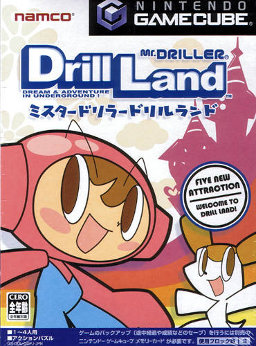
Mr. Driller Drill Land is a 2002 puzzle video game developed and published in Japan by Namco for the GameCube. It is the fifth entry in the Mr. Driller video game series, and the second developed for a Nintendo platform following Mr. Driller A. Controlling one of seven characters, the player must make it to the bottom of each stage by destroying colored blocks, which can connect to each other and form chain reactions. The game is divided into five different modes themed as amusement park attractions, which feature new mechanics such as enemies, items and different block types.
indieszero Corporation, Ltd. is a small video game development company headquartered in Musashino, Tokyo, Japan. It was founded on April 21, 1997, and has developed video games for other video game companies, including Nintendo, SEGA, and Square Enix.

Star Soldier is a shoot 'em up video game developed and published by Hudson Soft for the Nintendo Entertainment System and the MSX. The player pilots the starship "Caesar", travelling through space stations occupied by powerful supercomputers known as "Starbrains" who threaten the galactic empire. Star Soldier greatly resembles the earlier arcade game Star Force.

Yakuman (役満) is a 1989 mahjong video game developed by Intelligent Systems and published by Nintendo for its handheld Game Boy as one of the Japanese launch titles. It is the first entry in a series of first-party Japanese mahjong games on Nintendo systems, with sequels on the Famicom, Game Boy Advance, DS, Wii, Wii U, and 3DS.
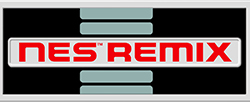
NES Remix is a compilation video game series for Wii U, developed by Nintendo. The first and eponymous game was simultaneously announced and released on December 18, 2013, on the Nintendo eShop following a Nintendo Direct presentation. A second game, NES Remix 2, was released on April 25, 2014. A retail edition consisting of both games, titled NES Remix Pack, was released on April 24, 2014, in Japan and December 5 in North America. Another title, Ultimate NES Remix for Nintendo 3DS, was released on November 7-8, 2014 in Europe and Australia, December 5 in North America and August 27, 2015, in Japan.

Mario vs. Donkey Kong is a puzzle-platform game series published by Nintendo. A spin-off of both the Mario and Donkey Kong franchises, the series marks the return of both Pauline and the rivalry between Mario and Donkey Kong.

Famicom Detective Club is an adventure game duology developed and published by Nintendo for the Family Computer Disk System. The first entry, The Missing Heir, was released in 1988, followed by a prequel released the next year titled The Girl Who Stands Behind. In both games, the player takes on the role of a young man solving murder mysteries in the Japanese countryside.

The Nintendo Entertainment System (NES), an 8-bit third-generation home video game console produced by Nintendo, had numerous model variants produced throughout its lifetime. It was originally released in 1983 as the Family Computer in Japan, with design work led by Masayuki Uemura. Nintendo intentionally redesigned it as the NES in North America in an attempt to avoid the stigma of video game consoles lingering from the video game crash the same year; while it was initially conceptualized as a home computer, it was ultimately modeled after a videocassette recorder (VCR) for its debut there in 1985. Nintendo subsequently exported the NES to Europe and Oceania via local distributors.




















